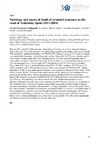Please use this identifier to cite or link to this item:
https://accedacris.ulpgc.es/handle/10553/71339
| DC Field | Value | Language |
|---|---|---|
| dc.contributor.author | Fernández Maldonado, Carolina | en_US |
| dc.contributor.author | Sierra Pulpillo, Eva María | en_US |
| dc.contributor.author | Arbelo, M. | en_US |
| dc.contributor.author | Diaz Delgado, Josue | en_US |
| dc.contributor.author | De La Fuente Marquez, Jesus | en_US |
| dc.contributor.author | Fernández Rodríguez, Antonio Jesús | en_US |
| dc.date.accessioned | 2020-04-14T16:16:36Z | - |
| dc.date.available | 2020-04-14T16:16:36Z | - |
| dc.date.issued | 2016 | en_US |
| dc.identifier.uri | https://accedacris.ulpgc.es/handle/10553/71339 | - |
| dc.description.abstract | Between 2011 and 2014, 538 cetaceans, representing 16 species, were found stranded along the Andalusian coast. This study describes the epidemiology, pathological findings and causes of death (CD; grouped as ‘pathological entities’) of 104/538 (19%) stranded cetaceans (11 species). Samples were analyzed for histology, microbiology and virology. From 104, 59 (57%) were females and 45 (43%) males. Twenty seven (26%) were neonates/calves, 48 (46%) juveniles/subadults and 29 (28%) adults. Nineteen (18%) were very fresh, 54 (51%) fresh, 28 (27%) moderate autolysis, and 4 (4%) advanced autolysis. Twenty-eight (27%) stranded alive, and 76 (73%) were found dead. Thirty-three (32%) were in good nutritional status (NS), 17 (16%) moderate, 39 (37%) poor, 12 (12%) emaciated, and 3 (3%) not determined. A CD was recognized in 95/104 (91,34%) studied individuals. Within natural pathological categories, those associated with good NS involved 17/104 (16%); whereas 36/104 (35%) presented significant loss of NS. Interaction with fishing activities encompassed 19/104 (18%). Neonatal/perinatal pathology enrolled 8/104 (8%). Fatal intra- interspecific traumatic interactions included 9/104 (9%). Ship collisions were determined in 2/104 (2%). Foreign body pathology was observed in 2/104 (2%). Within natural categories CD, infectious pathogens (bacteria, virus, fungi) represent the 64%. Parasitic disease was recognized in 30% with fatal cases involving Toxoplasma gondii and Crassicauda sp. Fatal neoplastic disease included a pulmonary carcinoma with metastases in a long-finned pilot whale (Globicephala melas) and a hepatocelular carcinoma with metastases in a striped dolphin. A case of a fatal asphyxiation in a long-finned pilot whale due to primary bronchi obstruction caused by an European eel (Anguila anguila) is reported. Direct human activity is responsible for approximately 22% of cetaceans deaths, while ‘natural’ pathologies would account for approximately 78%. This study significantly contributes to baseline knowledge on cetacean pathology. | en_US |
| dc.language | eng | en_US |
| dc.source | 30th Annual Conference of the European Cetacean Society. Madeira, Portugal, 14-16 March 2016 / Luís Freitas; Cláudia Ribeiro (ed.), p. 231 | en_US |
| dc.subject | 310907 Patología | en_US |
| dc.subject | 3109 Ciencias veterinarias | en_US |
| dc.title | Pathology and causes of death of stranded cetaceans on the coast of Andalusia, Spain (2011-2014) | en_US |
| dc.type | info:eu-repo/semantics/conferenceObject | en_US |
| dc.type | ConferenceObject | en_US |
| dc.investigacion | Ciencias de la Salud | en_US |
| dc.type2 | Actas de congresos | en_US |
| dc.utils.revision | Sí | en_US |
| dc.identifier.ulpgc | Sí | es |
| item.fulltext | Con texto completo | - |
| item.grantfulltext | open | - |
| crisitem.author.dept | GIR IUSA-ONEHEALTH 3: Histología y Patología Veterinaria y Forense (Terrestre y Marina) | - |
| crisitem.author.dept | IU de Sanidad Animal y Seguridad Alimentaria | - |
| crisitem.author.dept | Departamento de Morfología | - |
| crisitem.author.dept | GIR IUSA-ONEHEALTH 3: Histología y Patología Veterinaria y Forense (Terrestre y Marina) | - |
| crisitem.author.dept | IU de Sanidad Animal y Seguridad Alimentaria | - |
| crisitem.author.dept | Departamento de Morfología | - |
| crisitem.author.dept | GIR IUSA-ONEHEALTH 3: Histología y Patología Veterinaria y Forense (Terrestre y Marina) | - |
| crisitem.author.dept | IU de Sanidad Animal y Seguridad Alimentaria | - |
| crisitem.author.dept | GIR IUSA-ONEHEALTH 3: Histología y Patología Veterinaria y Forense (Terrestre y Marina) | - |
| crisitem.author.dept | IU de Sanidad Animal y Seguridad Alimentaria | - |
| crisitem.author.dept | GIR IUSA-ONEHEALTH 3: Histología y Patología Veterinaria y Forense (Terrestre y Marina) | - |
| crisitem.author.dept | IU de Sanidad Animal y Seguridad Alimentaria | - |
| crisitem.author.dept | Departamento de Morfología | - |
| crisitem.author.orcid | 0000-0003-3749-8845 | - |
| crisitem.author.orcid | 0000-0002-1623-5010 | - |
| crisitem.author.orcid | 0000-0003-1216-5446 | - |
| crisitem.author.orcid | 0000-0001-5281-0521 | - |
| crisitem.author.parentorg | IU de Sanidad Animal y Seguridad Alimentaria | - |
| crisitem.author.parentorg | IU de Sanidad Animal y Seguridad Alimentaria | - |
| crisitem.author.parentorg | IU de Sanidad Animal y Seguridad Alimentaria | - |
| crisitem.author.parentorg | IU de Sanidad Animal y Seguridad Alimentaria | - |
| crisitem.author.parentorg | IU de Sanidad Animal y Seguridad Alimentaria | - |
| crisitem.author.fullName | Sierra Pulpillo, Eva María | - |
| crisitem.author.fullName | Arbelo Hernández, Manuel Antonio | - |
| crisitem.author.fullName | Díaz Delgado, Josué | - |
| crisitem.author.fullName | De La Fuente Márquez, Jesús | - |
| crisitem.author.fullName | Fernández Rodríguez, Antonio Jesús | - |
| Appears in Collections: | Póster de congreso | |
Page view(s)
105
checked on Mar 15, 2025
Download(s)
34
checked on Mar 15, 2025
Google ScholarTM
Check
Share
Export metadata
Items in accedaCRIS are protected by copyright, with all rights reserved, unless otherwise indicated.
